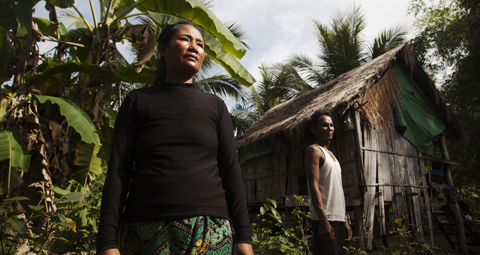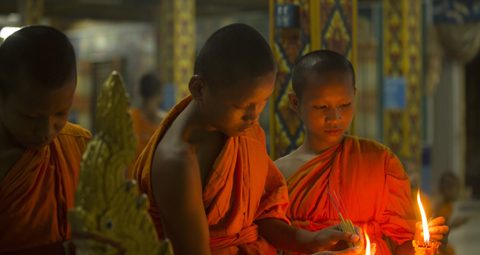BY Daniel Harkins | March 30 | ![]() 0 COMMENTS
0 COMMENTS ![]() print
print

Faith and violence in Cambodia
Reporting from Cambodia, DANIEL HARKINS looks at the work SCIAF are doing to help abused women in rural villages, and explore the faith of a country not so different from our own
Lip Nhy, 38, and Loat Om, 35, have differing views on their marriage problems. For Nhy, his wife caused the troubles by harassing him when he was out drinking. Om’s version is much more horrific. “He had a machete and threatened to kill me and the children,” she said. “I was very afraid.”
Cambodia has an understanding of gender roles at odds with that of the Western world. Woman in rural areas have hard lives. They work long hours in the field, manage the household and are expected to raise the children. It’s a structural misogyny that results in horrific domestic violence and a village culture that condemns a woman for her ‘failure’ to make a marriage work, rather than the man for his abuse.
The Scottish Catholic International Aid Agency (SCIAF) is helping to challenge this warped view. Through their local partner in Cambodia, Development and Peace in Action (DPA), they are funding schemes that help women trapped in abusive relationships; woman like Om, who is now back with her husband after they completed a course funded by the charity.
I spoke to Om and Nhy in their house in the northern region of Stung Treng. We talk on a raised wooden platform, surrounded by lush vegetation, and beneath a blue sky. Children run around catching bugs in jars and we snack on sour green fruit. It’s a beautiful surrounding, but there is a darkness over the family home. Nhy grins nervously throughout the interview. Om, interviewed separately, sits unsmiling. She seems painfully sad.
Her marriage was arranged by her parents, and she struggles to remember what she first liked about Nhy. He first hit her six months after their first child was born. She was slapped in the head and back. She went to the police, but they ignored her complaint because it was ‘the first time.’ The second, third and fourth times soon followed. “I was shaking and did not eat,” she said. “I was afraid that when I was asleep he might cut my throat.”
The SCIAF-funded programme helps couples and women affected by domestic violence. Women are taught to be more assertive. “Now I am not afraid: if he hits me I will hit him back,” Om said. The programme can be clumsy and insensitive to western eyes—Om was told to be ‘a good housewife’ and to not ‘annoy her husband’—but it offers the only support to women in isolated regions devoid of the women’s shelters and progressive values found in Scotland. It tackles the alcoholism that is the root cause of much domestic violence, and emphasises the need for men to help in the household.
Beyond SCIAF, Om relies on her Buddhist faith for help. She tells me that during her worst times she avoided going to the pagoda—‘it made me sad because I should only bring good things, not the bad’ to the temple—but she took part in village ceremonies.
As with Om, a religious faith helped Ban Sury, 38, when her husband became abusive. Sury and Khut Num, 42, fell in love when Num was a monk.
Num recalled falling for his future wife when her first saw her working in a field. “She’s very pretty, and strong—she built this house herself,” he said, gesturing to the wooden building we are in.
They married for love—the union was not arranged by their parents—but the relationship broke down when Num became addicted to a poisonous homemade rice wine. There was no physical violence, but Nun would shout and swear and throw plates at the wall.
Sury said SCIAF’s local partner DPA ‘taught us to be patient, to forgive each other’ and that it ‘made me realise my husband’s behaviour was wrong.’ But it took a medical treatment—funded by selling one of their fields—to salvage their marriage.
“I often prayed for help,” Sury said. “Life is hard for women in Cambodia because the men do one thing and the woman does everything.”
Domestic violence is just one of Cambodia’s problems. The country has suffered from a half-century of war and political upset. Poverty is a widespread problem away from the tourist hotspots of the capital city and the famous Angkor Wat temple complex.
Travelling out of Phnom Penh, you notice the lack of major infrastructure works. There are no multilane highways, just single-track roads with small buildings crowding either side.
Outside almost every one of these is a small shrine. Business-owners pray and make offerings each morning in the hopes of a productive day’s trade. The Buddhist religion is ever present in the country, though my translators tell me that young people are increasingly non-religious. They still visit the pagoda for big ceremonies, and their parents are filled with faith, but they aren’t much involved themselves. Cultural Buddhists you might say. Halfway across the world, people have the exact same problems as here in Scotland.
In the small town of Stung Treng however, I meet some young people who buck the trend. A pagoda in the town is filled with monks—children, teenagers, and 20-somethings. Soeng Sophea, 30, and Raing Sopha, 21, are dressed in the traditional orange robes.
Their day starts at 4am with prayer followed by English language classes. They study for much of the day, pray, collect offerings of food and clean the compound.
Sophea tells me he takes his faith seriously. He joined the pagoda with 10 friends, but most of them left as they didn’t have the patience.
Fellow monk Sopha was sent to the pagoda by his family as they couldn’t afford to send him to school. In Cambodia, there is a tradition of poor families sending their children to become monks in order to get a good education. Unlike with the priesthood, someone might only become a monk for a period before leaving and getting married.
“My whole family have high hopes for me,” Sopha said. “But there’s no pressure as my parents have always supported me.”
Watching the monks from a distance, dressed in their robes, praying solemnly, you can get the impression of deeply holy men. But many of them are, in the words of my photographer, ‘just lads.’ Sophea tells me that he watches movies—he’s a big Rambo fan.
Later, I find myself on my knees praying with a group of monks who chant in unison for 20 minutes straight. I’m anxious to be respectful, to not get anything wrong, but when I glance over at Sopha he is on Facebook on his mobile.
Across town, I speak to Phanphuong Thavy, in St Johan’s Catholic Church. Thavy, 34, is the catechesist here, teaching children in the church and in the school next door. There are around 50 people in the parish, mostly Vietnamese migrant workers and their children and a few Cambodian Catholic families.
“My father was a Buddhist and my mother was Christian,” she said. “When I was young I would always follow my mother to the church so I became a Christian.”
The parish priest at St Johan’s, Fr John Park Seopil, is South Korean and has been here since 2002. St Johan’s is the only Catholic church in the province. Fr Park is based in another province, and comes to celebrate Mass each Sunday. Before Fr Park, the church would have a visit from a priest only once every three months.
As one of the very few Catholics in the town, Thavy sometimes struggled. “In the past it was difficult because sometimes I would be teased for being a minority,” she said. “But now it is fine—people got used to it.”
This is how the Catholic Faith survives in a country like Cambodia. In Scotland we complain about priest shortages and parish closures, but despite living in a country where Catholicism is a small minority we would never wait three months for a priest. Catholicism survives here in fits and starts, through sacrifice and adaptation. St Johan’s, for instance, has no pews—parishioners follow the Buddhist practise of sitting on the floor during ceremonies.
Less than 0.15 per cent of the population in Cambodia are Catholic. Which raises the question of why a Catholic charity is spending its funds here. “Each and every person is made in the likeness of God and it’s got nothing to do with what expression of truth they’ve found for themselves,” SCIAF director Alistair Dutton said when asked about the charity’s work helping non-Catholics. “It’s to each according to their need. When we are asked [by God] on that final day ‘who did you feed and who did you water’ we aren’t asked ‘did they believe in me?’ We are Catholic in our inspiration but we serve absolutely everybody.”
That includes women who are trapped in abusive relationships; fishing villagers intimidated by militarised gangs; companies who pray on landless people; and those, in Cambodia as across the world, who suffer the devastating effects of the climate change.
Before I left the pagoda in Stung Treng—the monks had finally finished their interminable chanting—Sophea grabbed my photographer and I for a selfie. Another colleague learned, via a Google voice translator app, that the other monk, Sopha, wanted to add him on Facebook. The people SCIAF are asking you to help this Lent may be half the world away, speaking a foreign tongue, and practising another religion, but they are no different from you and me—and they need our help.
– To get a SCIAF Wee Box or find out more visit www.theweebox.org or call 0141 354 5555














